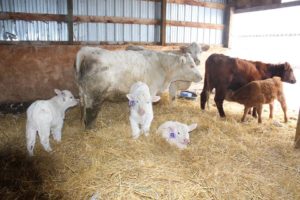Maximising Calf Survival
26 March 2018 With calving time starting it would be worth considering what could be implemented to maximise the survival rate of new born calves. Calf losses can be significant not just at calving but in their first three weeks of life. Nobody wants to put all that effort in to lose them. The better conditions are for young calves at calving, the better survival rates will be.
With calving time starting it would be worth considering what could be implemented to maximise the survival rate of new born calves. Calf losses can be significant not just at calving but in their first three weeks of life. Nobody wants to put all that effort in to lose them. The better conditions are for young calves at calving, the better survival rates will be.
With recent poor weather we face many challenges such as damp, wet conditions along with shortages of bedding material both of which will reduce environmental hygiene and increase the risk of calf scour.
On the majority of farms deaths represent only a small proportion of the total cost of a scour outbreak. The biggest costs are treatment and reduced lifetime performance as calves that recover from scour attack are more susceptible to other diseases such as pneumonia.
What do farms with excellent rearing rates do to make a difference? They simply maximise prevention rather than relying on treatment to provide a cure.
- Maintaining good dry calving areas so reducing any risk of infections when the calf is born from wet dirty bedding. Straw may be relatively expensive but it is still cost effective when compared to calf losses. Woodfines can also be considered but can increase risk of navel infections
- Vaccination for Rotavirus,Coronavirus and E Coli should be routine in late pregnancy to increase Colostral antibodies to these common scour agents.
- Ensuring sufficient Colostrum early on in the first 2 to 3 hours is critical to ensure protection against scour and septicaemia. Overall, calves require to consume 10% of their body weight of colostrum in the first 12 hours. For a 45 kg calf this will equate to 4.5 litres total. The ones to watch are calves that have had a prolonged or difficult birth as firstly they are less likely to suck and when they do they will not absorb colostral antibodies as well.
- Routine practice by many is to treat the newborn calf’s navel twice within 12 hours.
- Those who have had previous issues or wish to prevent Cryptosporidiosis may treat all calves born with specific drench for the first few days of life. Risk and preventative strategies need to be discussed with your vet. It is one of the most common causes of calf scour in the UK. It is caused by a parasite called Cryptosporidium and is usually seen in young calves less than three weeks old. Symptoms include diarrhoea, dehydration, loss of appetite, fever and abdominal pain
- Both the calving areas and calved cow sheds are cleaned out, power washed and disinfected on a weekly to fortnight basis using products developed to be effective against bacteria and viruses with cryptosporidiosis often being the main target. Many farms state that this makes a significant impact on calf survival .
- If calving cows are held indoors due to bad weather then consider moving the late calving cows into a fresh bedded shed away from the existing calved group as infection challenge levels will have built up to high levels in the main calving group/shed.
Gavin Hill, gavin.hill@sac.co.uk
Sign up to the FAS newsletter
Receive updates on news, events and publications from Scotland’s Farm Advisory Service
